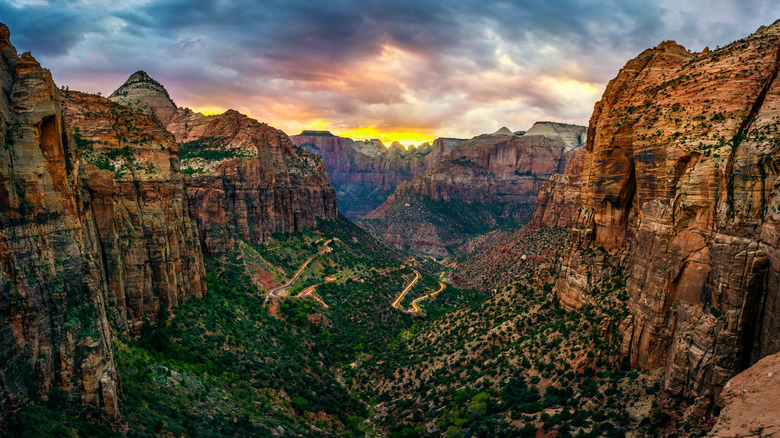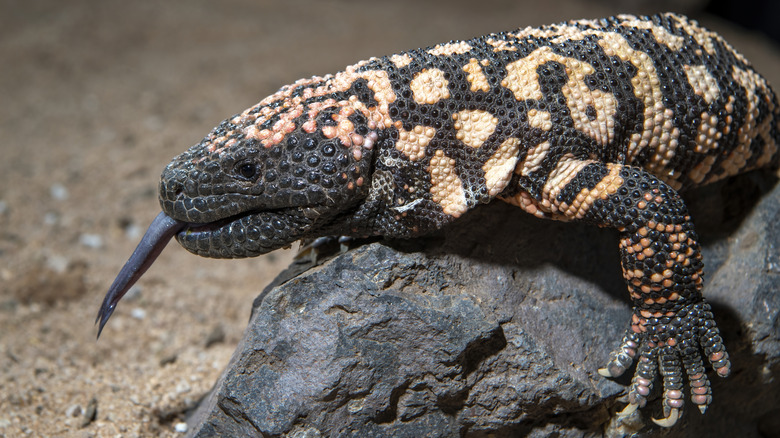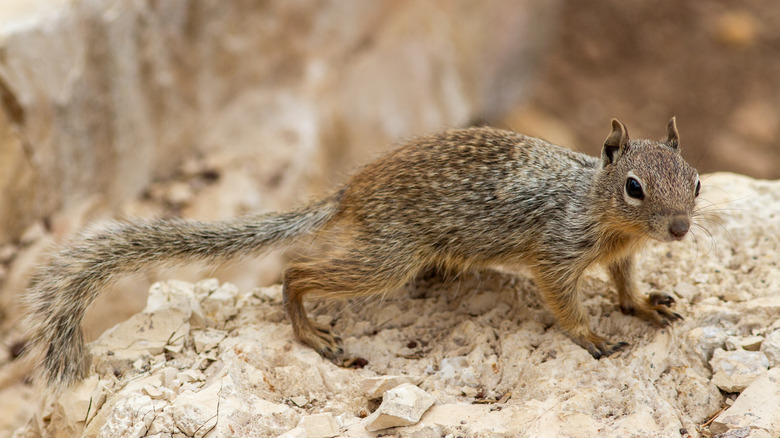5 Creatures To Beware Of When Adventuring In Zion National Park
With summer rolling in, outdoor adventurers are eager to cross off more of America's national parks from their bucket lists. For parks such as Zion National Park, renowned for its unique sandstone and desert landscapes, summer presents an ideal opportunity to explore, which might be the reason why the summer months are Zion's busiest times of the year. While running into fellow nature-lovers is an exciting part of the outdoor experience, with increased foot traffic there is more room for danger. One of the reasons for this is that with more people around, the odds increase for wildlife encounters. Though there are many myths about animals and wildlife encounters that don't merit any belief, there are some animals that warrant being wary of.
Zion National Park boasts a rich biodiversity, harboring more than 400 species of mammals, reptiles, birds, and fish within its borders. You might be lucky enough to spot a Californian condor soaring through the skies or a mule deer leaping over the park's rugged terrain. While it is good practice to avoid approaching any animals at a national park, there are some at Zion that you should absolutely stay clear of for your own safety. These are five creatures to beware of when adventuring in Zion National Park.
Gila monster
There are only two venomous lizard species in North America. The colorful Gila monster is one of them. They sport quite a striking appearance, typically featuring bright orange, pink and black bands on their skin. They have a stocky build and are actually the largest lizards in the U.S. They are well adapted to the harsh conditions of the desert in Zion National Park, but they spend most of their time sheltering in burrows or under rocks during the heat of the day. While they typically are found on the ground, they are capable climbers and can be found in treetops.
The danger of Gila monsters lies in their venom. Though the venom is not fatal, it causes intense pain and swelling in those who are bitten. Fortunately, Gila monsters typically only inject their venom for self-defense, which means that if you run into a Gila monster, if you keep away and present yourself as non-threatening, you are likely to get away scot-free.
Great Basin rattlesnake
Where there are deserts, there are usually rattlesnakes. The Great Basin rattlesnake is the only venomous rattlesnake in Zion National Park. However, it is far from the only type of snake that might slither across your path. It may be hard to distinguish a Great Basin from most other snakes since it is adapted to camouflage well, but a telltale sign could be if it is rattling its tail, in which case, you should be very careful not to agitate the snake even further.
That said, according to the National Park Service, you may encounter a baby Great Basin rattler that has not yet grown its rattle, and the tell-tale rattles of mature snakes can sometimes "break off" so the warning wouldn't be there. Not only that, but another Zion snake, the non-venomous Great Basin gopher snake mimics the rattlesnake's shaking, rattling tail as a defense mechanism — so it's best to just stay clear of any snakes.
If you do run into a rattlesnake while hiking, it is important to give space and time for the snake to move back first. Give it ample room and avoid moving closer to it. If you must go in the direction of the rattlesnake, wait quietly and non-imposingly until it has moved away. After it has slithered off, stomp the ground so that the snake can feel the your vibrations. This will hopefully encourage the snake to venture off so that you don't encounter it again.
Africanized killer bee
When we picture dangerous creatures, we tend to think of big ferocious animals prowling in the wilderness, but often, it is the tiny insects that will get you. Take, for instance, the Africanized killer bee.
These bees are notorious for being aggressive, making them the most dangerous type of bee. Unlike their more docile European counterparts, Africanized bees will not hesitate to attack in defense of their nest. If they do perceive a threat, they are relentless, pursuing anyone and anything over vast distances and in large swarms. What's particularly concerning is their ability to nest anywhere. This means they could be lurking in unsuspecting nooks, branches, and bushes along hiking trails. It's a good thing that dogs aren't allowed on most trails in Zion National Park, because a curious dog's misstep could trigger an attack.
If you do ever find yourself in such an unfortunate circumstance — R-U-N. Run for as long as you are able, and seek out and stay under cover until the bees tire out and fly away.
Rock squirrel
Rock squirrels are small creatures that look cute, but are deceptively dangerous. They may approach visitors and campsites in search of food, which is why it is extremely important to store your food correctly while camping. They are clever animals, able to squirrel their way into bags and tents. At times, they have even been known to paw food out of peoples' hands.
At Zion National Park, rock squirrels are often seen on the Riverside Walk trail (per National Park Service), so it is best to keep your eyes peeled on the ground and surrounding vegetation in case one of these furry animals springs up on you. If you do run into one, do not try to appease the squirrel by offering it food. Often, rock squirrels cannot digest human food, so feeding one may make you responsible for a squirrel's untimely death. It is best to keep walking and avoid interacting with the squirrel. If you have food that may be enticing to it, wrap it up and pack it away as you make distance.
Bighorn sheep
Utah is a hotspot for viewing bighorn sheep. They are known for their impressive curved horns, and agile climbing abilities. They have evolved to have strong hooves that can hold onto steep rocks and cliffs. These adaptations serve them well since the mountain terrain they occupy is also home to mountain lions, which feed on bighorns.
While they are typically harmless, they do become aggressive during the rutting season which is from July to October. Males, known as rams, engage in head-butting battles to compete for mates. These clashes can get pretty intense, resulting injuries for the animals involved.
Visitors who go to Zion National Park with the intention of viewing and photographing bighorn sheep may fall into the trap of approaching one of these animals too closely. This is when accidents are most likely to occur, since your advances may be mistaken as threats. Though it is easy to get wrapped up in the moment, the best precautionary measure that one can take is keeping a minimum of 100 feet away from these larger animals, per the National Park Service.





